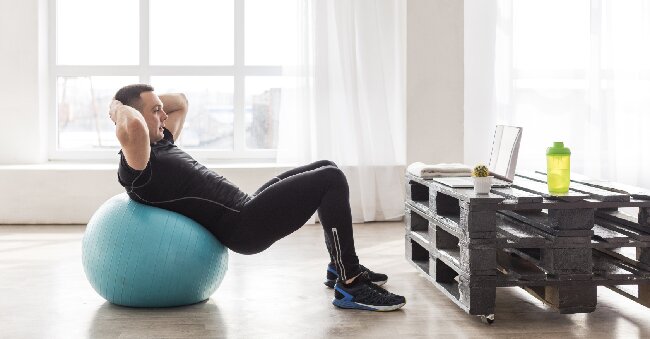
Comprehensive Exercise Balls Size Guide: Find the Perfect Fit from 45 cm to 95 cm
Seeking to enhance your workout routine with an exercise ball but uncertain about the appropriate size to select? This detailed size guide covers options ranging from 45 cm to 95 cm, highlighting factors such as body weight, height, fitness level, and intended use to take into account when making your choice. The guide offers advice on proper inflation, stability exercises, and safety measures to optimize your workout session. Discover the ideal exercise ball for your requirements and prepare to engage in a productive workout.
Size Guide for Exercise Balls
In terms of Exercise Balls, selecting the correct size is important for optimizing workout effectiveness and comfort. Understanding the detailed size guide and choosing the appropriate size according to individual needs and preferences is crucial for a successful fitness regimen.
Choosing an exercise ball that matches your height is key to maintaining proper form during exercises. Individuals under 5’4″ are advised to use a 55cm ball, while those between 5’4″ and 5’7″ may find a 65cm ball more suitable. Taller individuals over 5’7″ typically prefer a 75cm ball. It’s also important to consider the intended use, as smaller balls are great for core strengthening while larger balls are better for stability and balance exercises.
1. 45 cm (18 inches)
The 45 cm Exercise Ball, measuring 18 inches in diameter, is a commonly chosen option for individuals seeking to enhance their core strength and stability. Its smaller size is advantageous for stability exercises, as it necessitates increased control and activation of core muscles to uphold balance. The 45 cm Exercise Ball is especially useful for smaller individuals or beginners, providing a more approachable starting point in comparison to larger alternatives. The reduced diameter also permits a wider range of motion during exercises, promoting enhanced muscle engagement and flexibility. Through the utilization of the 45 cm Exercise Ball, individuals can efficiently target their core muscles, enhance balance, and improve overall stability.
2. 55 cm (22 inches)
The 55 cm Exercise Ball, measuring 22 inches in diameter, is a versatile choice suitable for a wide range of exercises and users. Its compact size makes it ideal for smaller spaces and individuals of varying heights who may find larger exercise balls cumbersome.
The 55 cm Exercise Ball is perfect for targeting core muscles, improving balance, and enhancing stability during workouts. Compared to larger exercise balls, the 55 cm size offers greater support for beginner users or those looking to focus on specific muscle groups. Its size also allows for a wider range of motion and flexibility exercises, catering to diverse fitness needs.
3. 65 cm (26 inches)
The 65 cm Exercise Ball has a diameter of 26 inches, providing enhanced stability and support for users participating in exercises that require proper body alignment.
Its size is suitable for a variety of workout routines, including core strengthening, balance training, and stretching exercises. The 65 cm Exercise Ball serves as a stable foundation for activities like squats, planks, and pelvic tilts, aiding in posture improvement and injury prevention.
Compared to smaller exercise balls, the 65 cm option offers a larger surface area, enhancing stability during workouts. This makes it a preferred choice among fitness enthusiasts looking for versatility and comfort in their exercise equipment.
4. 75 cm (30 inches)
The 75 cm Exercise Ball, with a diameter of 30 inches, offers individuals seeking enhanced balance and core engagement during workouts a larger surface area for a variety of exercises.
The increased size of the 75 cm Exercise Ball is beneficial for those looking to challenge their balance and effectively target different muscle groups. In comparison to smaller exercise balls, the 75 cm option provides greater stability, making it suitable for a wide range of exercises, including core workouts and stretching routines. Its versatility enables users to perform dynamic movements that can enhance coordination and strengthen core muscles.
Whether one is a beginner or a seasoned fitness enthusiast, the 75 cm Exercise Ball can accommodate diverse workout needs with its ample space for movement and stability.
5. 85 cm (34 inches)
The 85 cm Exercise Ball, or 34 inches in diameter, is ideal for taller users and those seeking enhanced stability during workouts. Its larger size promotes better posture and alignment, reducing strain and injury risk, while offering a firmer surface for exercises like planks and bridges. Choosing the right ball size based on height and fitness goals can greatly improve exercise effectiveness.
6. 95 cm (38 inches)
The 95 cm Exercise Ball, with a diameter of 38 inches, offers a spacious and stable surface for users engaging in exercises that require a larger fitness ball.
The ample size of the exercise ball provides enhanced stability during core exercises, making it ideal for activities like planks, crunches, and stability ball push-ups. Its larger surface area also allows for a wider range of motion and better weight distribution compared to smaller exercise balls, contributing to improved balance and muscle engagement.
When compared to smaller balls, the 95 cm Exercise Ball is better suited for taller individuals as it provides a more comfortable and secure base for exercises such as squats and lunges. Choosing the right size exercise ball can significantly impact the effectiveness of your workout routines, so opting for the 95 cm option offers a versatile and supportive choice for various exercises.
Factors to Consider When Choosing a Size
When selecting the appropriate Exercise Ball size, various factors should be taken into consideration, such as height, fitness level, and intended use for the stability ball. These factors are essential as they directly impact the efficacy and safety of your workout routine.
For example, taller individuals may need larger exercise balls to maintain proper alignment during exercises, whereas those with lower fitness levels may find it beneficial to start with smaller sizes for improved stability and control.
The specific exercises you intend to engage in, whether focused on core strengthening, balance training, or rehabilitation, will also influence the most suitable exercise ball size to optimize your overall fitness experience.
1. Body Weight
The size and weight capacity of the Exercise Ball should be chosen based on an individual’s body weight to ensure safe and effective workouts.
Considering the body weight when selecting an Exercise Ball is important because each stability ball is made to support a specific weight capacity. Choosing a ball with the suitable weight limit allows for exercises to be performed confidently and stably. For those with higher body weights, it is advised to select an Exercise Ball with a higher weight capacity to avoid any potential risk of bursting or collapsing during use. Taking into account the weight capacity enhances the safety and effectiveness of the exercise routine.
2. Height
The height of an individual is an important factor in determining the appropriate size of an Exercise Ball to maintain proper body alignment and posture during exercises. Selecting the correct Exercise Ball size based on height is essential to ensure optimal performance and comfort during workouts.
For individuals who are under 5 feet tall, a 45 cm Exercise Ball is recommended, while those between 5’1″ and 5’8″ should choose a 55 cm ball. Taller individuals, those above 5’8″, will find a 65 cm ball more suitable.
Using the right-sized Exercise Ball encourages proper spinal alignment, effectively engages core muscles, and helps prevent injuries, thereby enhancing the productivity and enjoyment of workouts.
3. Fitness Level
Consider your fitness level when selecting an Exercise Ball to ensure it complements your exercise routine and aligns with your fitness goals.
Choosing the appropriate size of an Exercise Ball can have a significant impact on the effectiveness of stability exercises and overall fitness performance. Beginners may find that a larger Exercise Ball offers greater stability, making it suitable for foundational exercises like hamstring curls and core activation. Intermediate users might benefit from using a slightly smaller ball to challenge balance and core strength in exercises such as planks and Russian twists. Advanced users often prefer the smallest ball size to increase workout intensity, engaging smaller stabilizing muscles during movements like push-ups and squats.
4. Intended Use
When choosing an Exercise Ball, it is important to identify the intended use, whether it be for Pilates, yoga, rehabilitation, or general fitness, in order to select the appropriate size that aligns with the exercise regimen.
For Pilates and yoga practitioners, a slightly larger Exercise Ball size might be advantageous as it allows for a wider range of motion during exercises such as the plank or bridge. Conversely, individuals interested in incorporating stability exercises into their fitness routine may prefer a smaller size to enhance balance and core strength.
Selecting the correct size is crucial when focusing on rehabilitation exercises as it ensures proper alignment and support. Seeking guidance from a fitness professional can help determine the ideal Exercise Ball size based on specific workout equipment needs.
Additional Tips for Using Exercise Balls
Incorporating exercise balls into a fitness routine offers a variety of health benefits. However, ensuring proper inflation, practicing stability and balance exercises, and following safety precautions are essential for a safe and effective workout experience.
Maintaining the correct inflation level of the exercise ball is crucial for safety and optimal performance. Over or under inflating the ball can affect its stability during exercises. To determine the right inflation level, it is recommended to follow the manufacturer’s guidelines or use a measuring tape to ensure it is inflated to the proper diameter.
Exercise balls can be used for stability and balance exercises like planks, squats, and crunches to effectively engage core muscles. It is important to place the ball on a clean, flat surface to prevent potential punctures or slips during use.
1. Proper Inflation
Achieving the correct inflation level of an Exercise Ball is important for optimal performance and user comfort. Following the inflation instructions and using the provided pump for adjustments can help in this process.
Proper inflation directly affects the stability and effectiveness of workouts, so understanding the correct procedure is crucial. To start, insert the pump nozzle into the designated hole of the exercise ball. Firmly hold the ball and pump air gradually, taking breaks to check the firmness by pressing on it.
Avoid overinflating the ball as it can impact its durability. The included pump simplifies the process and helps in maintaining the desired inflation levels effortlessly.
2. Stability and Balance Exercises
Participating in stability and balance exercises with an Exercise Ball is a great method to boost core strength, enhance balance, and encourage overall body alignment.
These exercises are beneficial for engaging multiple muscle groups simultaneously, resulting in a more effective workout. By including exercises like stability ball crunches, planks, and squats into a routine, individuals can challenge their core muscles in a dynamic manner.
Utilizing an Exercise Ball for balance exercises can enhance proprioception, which is the body’s capacity to perceive its position in space. This increased awareness can lead to improved coordination and stability in everyday activities and sports.
3. Safety Precautions
It is essential to prioritize safety precautions when using an Exercise Ball to prevent injuries, maintain proper form, and ensure a safe workout environment.
When using an Exercise Ball, it is important to select the correct size based on your height and weight to minimize the risk of injury. Before each use, always check the ball for any signs of wear and tear to avoid unexpected accidents. Proper inflation is crucial; overinflation can result in bursting, while underinflating can lead to instability. Positioning the ball on a flat, non-slip surface is advisable to prevent slipping accidents during exercises. Regularly cleaning the ball and storing it in a safe location away from sharp objects will help extend its lifespan and keep it in good condition.




No Comments